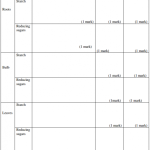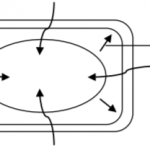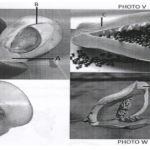KNEC KCSE Biology Paper 1 Question Paper / 2015 KCSE Gem Sub-County Joint Evaluation
BIOLOGY PAPER 1 QUESTION PAPER
2015 KCSE Gem Sub-County Joint Evaluation
Biology Paper 1
Name the organelle that performs each of the following functions in a cell.
a) Protein synthesis ………………………………………………………………….. (1 mark)
b) Transport of all secretions ……………………………………………………………………. (1 mark)
2 marks
The table below shows differences in the relative concentrations of various ions in the cell sap of a sea weed (valonia) and in
the sea water in which it is growing.
Ions Relative concentrations in%
Valonia cell sap Sea water
Chloride 21.2 19.6
Sulphates 0.005 3.33
Sodium 2.1 10.9
Magnesium 0.001 1.31
a) Name the process by which the following ion will enter the cell sap of the valonia cells.
i) Sulphates …………………………………………………………………………………………………… (1 mark)
ii) Chlorides ………………………………………………………………………………………………. (1 mark)
b) Give a reason for each of your answers in (a) (i) and (a) (ii) above. (2 marks)
4 marks
In an experiment, raw banana was peeled, mashed into a paste and was treated as shown in the set-up below.
a) Name the physiological process being investigated. (1 mark)
b) State the expected colour of the solutions inside the visking tubing after 30 minutes. (1 mark)
c) Explain the observation made in (b) above. (2 marks)
4 marks
a) State two functions of tongue during digestion in the mouth of man. (2 marks)
b) The following experiment was set up to investigate the action of protease on egg white.
After 15 minutes, the contents of the beaker became clear, explain this observation. (2 marks)
4 marks
The flow diagram below represents photosynthesis process. Study it and answer the questions that follow.
Name the substances: (_ mark)
4 marks
a) Distinguish between transpiration and guttation. (2 marks)
b) The diagrams below shows two types of patterns of lignification in xylem vessels.
4 marks
a) List two adaptation of leucocytes to their functions. (2 marks)
b) Differentiate between O+ and O- blood group. (1 mark)
3 marks
a) Explain why it is not possible to drown a locust while holding its head under water. (2 marks)
b) State two mechanisms of opening and closing of stomata. (2 marks)
4 marks
In an experiment to measure gaseous exchange between flying locust and its surrounding it was found that for every 1cm3 of carbon (IV) oxide, 1.43cm3 of oxygen was consumed.
i) Calculate the respiratory quotient forthe food substance that was being oxidised. (2 marks)
ii) State the importance of respiratory quotient. (2 marks)
4 marks
Name the main nitrogenous wastes excrete by:
i) Birds …………………………………………………………………………………………………………………………………
ii) Shark ………………………………………………………………………………………………………………………………
iii) Cow ……………………………………………………………………………………………………………………………….
3 marks
The table below shows percentage composition of blood plasma and urine from different substances.
Substance Blood plasma % Urine %
Water 90 90
Plasma proteins 8 0
Glucose 0.2 0.1
Urea 0.03 2
a) Explain why;
i) There are no plasma proteins in the urine. (1 mark)
ii) Urea concentration is greater in the urine than in the blood plasma. (1 mark)
iii) There is glucose in the urine (1 mark)
3 marks
a) The diagram below represents an organism.
i) Name the kingdom to which the organism belong. (1 mark)
ii) Give a reason for your answer in a (i) above. (1 mark)
b) Give two reasons why classification is important. (2 marks)
4 marks
A student named cockroach as AMERICAN PERIPLANTA.
a) Identify two mistakes in the name above. (2 marks)
b) Write the correct name of cockroach. (1 mark)
3 marks
State two density dependent factors that affect population growth in an ecosystem.
2 marks
The following organisms were found in a grassland habitat.
Organism Abundance
Insects 500,000
Snacks 200
Green plants 2,000,000
Mangrove 5
a) Construct a pyramid representing representing the order of feeding in the grassland. (1 mark)
b) Describe two features expected along trophic levels of pyramid constructed. (2 marks)
3 marks
The diagram below shows a cell undergoing a stage in a cell division.
a) Identify the stage…………………………………………………………………….. (1 mark)
b) Give a reason for your answer in (a) above. (1 mark)
c) What is the functions of the part labelled Q. (1 mark)
3 marks
List two possible effects that are likely to occur if the maternal and foetal circulatory system were directly connected.
3 marks
State two characteristics of meristematic cells.
2 marks
The diagram below represents a young root and four cells which occur in different regions of the root tip labelled K, L, M and N.
State the regions of the root tip where each of the cells A B C D occur.
4 marks
State two functions of DNA.
2 marks
Below is a nucleic strand.
a) Name the nucleic acid. (1 mark)
b) Give a reason for your answer in (a) above. (1 mark)
c) Write down the complimentary base pairing the pattern in the nucleic acid formed above. (1 mark)
3 marks
State the limitations of fossils as an evidence of evolution.
2 marks
i) The length from tail tip to the anus in a fish is 8cm whereas that from tail tip is 24cm. Calculate the tail power of the fish.
(2 marks)
ii) What is the significance of the high tail power in fish locomotion. (1 mark)
3 marks
The diagram below shows an eye defect.
State the defect. (1 mark)
1 marks
a) Distinguish between exocrine and endocrine glands. (1 mark)
b) State the functions of the following parts of mammalian ear:
i) Tympanic membrane (1 mark)
ii) Eustachian tube. (1 mark)
3 marks
State the importance of Endoskeleton.
3 marks
Give three types of movable joints found in mammalian skeleton.
3 marks





